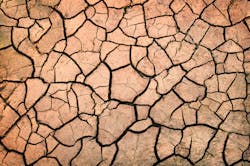Unprecedented Water Rationing in Chile is a Taste of Changes to Come
‘Day Zero’ was applied in 2018 to the projected date when municipal water supplies would be turned off in Cape Town, South Africa. In the lead up to that date, residents had to queue for their
daily ration of water. Day Zero was narrowly avoided thanks to rationing, water saving measures and eventual rains.
Four years later, and there is talk of another Day Zero, this time in Santiago, Chile, where water rationing is now in place. The Central Chile Mega Drought is the worst in the history of modern Chile. 2021 was Chile’s driest year since measurements began, with an average of 50% less rainfall in many regions.
Droughts often get less attention because they develop slowly over time – the Chilean one began in 2010. Their impacts can be severe, such as breadbasket failures that cost many lives, damage to economies and political instability. Severe droughts are occurring in Eastern Africa, such as in Madagascar, causing a famine affecting over 1 million people. In the western United States, a drought that started in 2000 is now the driest two decades in 1,200 years.
Many experts say with high confidence that human activity has increased the frequency of heatwaves and droughts on a global scale. In Chile, both natural variability and anthropogenic forces are at play. The mega drought is largely driven by changes in sea surface temperature anomalies (unrelated to El Niño) that lead to weather patterns hindering the passage of extratropical storms over central Chile, storms that usually bring precipitation. And while it is not possible to precisely quantify the climate change effect, an educated guess would put it between 25 and 50%.
According to the GAR Special Report on Drought (United Nations Office for Disaster Risk Reduction, 2021), there is hardly a sector that remains untouched by drought – from water supply (and the impacts on sanitation, water quality, wastewater management, etc.) to agriculture to power generation to infrastructure damage due in part to soil erosion. The list goes on.
Is this our future? There isn’t a single answer for the whole world. But extreme weather events are on the increase, according to the U.N.’s Intergovernmental Panel on Climate Change (IPCC) report, Climate Change 2022: Impacts, Adaptation and Vulnerability. It reported with ‘high confidence’ that increasing weather and extreme climate events have exposed millions of people to reduced water security with the largest impacts in Africa, Asia, and Central and South America. Moreover, extreme climate events, especially droughts, are likely to result in “involuntary migration” (translation: more refugee crises) and “violent intrastate conflict.”
In Chile, water availability has dropped 10% to 37% over the last 30 years and could drop another 50% in north and central Chile by 2060. Given its origin in ocean–atmosphere variability, a reversal can be expected in due course. Nevertheless, anthropogenic forces will keep pushing Chile towards dry conditions during the rest of 21st century with an intensity that depends on CO2 emission levels.
Water rationing in Santiago, as it was for Cape Town, is a necessary measure given the circumstances. Rationing was one reason Cape Town avoided a water apocalypse. Chile may want to consider similar plans for the rest of the country since it is not clear how long this will continue.
But these are reactive solutions. We know droughts and other extreme weather events are going to happen, so instead of waiting to provide relief once the crisis arrives, we can plan preventative measures. For example, the Volta Basin in West Africa has been affected by flood and drought, generating social, economic and environmental losses affecting almost two million people over the last 20 years. Currently there is a project being implemented to design a large-scale early warning system to alert civil protection services before disaster strikes, to reduce vulnerability, and to increase the capacity of communities to adapt to the new reality of worsening floods and droughts.
Long-term solutions include investing in early warning systems. U.N. Secretary-General António Guterres has called on the World Meteorological Organization (WMO) to “spearhead new action to ensure every person on Earth is protected by early warning systems within five years.” These systems anticipate risk which can then improve drought policies by clearly spelling out mitigating actions. Stakeholder participation, educational programs and public awareness are critical to planning the responses that protect vulnerable communities. That is why Global Water Partnership and the WMO set up the Integrated Drought Management Programme. It provides a HelpDesk that advises countries and provides guidelines for disaster risk reduction, climate adaptation strategies, and national water policies.
So we know what to do. Holistic, integrated approaches to water management are crucial. But we also need leaders to exercise the political will necessary to prioritize water management. One recent example is the Action Plan on Global Water Security announced by the United States. GWP urges other nations to take similar action by treating water management as a national priority, not only on paper, but by truly investing in improved water management.
Darío Soto-Abril is the Executive Secretary of Global Water Partnership (GWP). Valentin Aich, GWP’s Senior Water and Climate Specialist, contributed to this piece and works with the Integrated Drought Management Programme and the Associated Programme on Flood Management.


